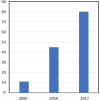Beneficial Services of Arbuscular Mycorrhizal Fungi - From Ecology to Application
- PMID: 30233616
- PMCID: PMC6132195
- DOI: 10.3389/fpls.2018.01270
Beneficial Services of Arbuscular Mycorrhizal Fungi - From Ecology to Application
Abstract
Arbuscular mycorrhiza (AM) is the most common symbiotic association of plants with microbes. AM fungi occur in the majority of natural habitats and they provide a range of important ecological services, in particular by improving plant nutrition, stress resistance and tolerance, soil structure and fertility. AM fungi also interact with most crop plants including cereals, vegetables, and fruit trees, therefore, they receive increasing attention for their potential use in sustainable agriculture. Basic research of the past decade has revealed the existence of a dedicated recognition and signaling pathway that is required for AM. Furthermore, recent evidence provided new insight into the exchange of nutritional benefits between the symbiotic partners. The great potential for application of AM has given rise to a thriving industry for AM-related products for agriculture, horticulture, and landscaping. Here, we discuss new developments in these fields, and we highlight future potential and limits toward the use of AM fungi for plant production.
Keywords: Glomeromycota; abiotic stress; arbuscular mycorrhiza; plant growth; plant nutrition; plant protection; soil structure; symbiosis.
Figures





References
-
- Adriano D. C., Wenzel W. W., Vangronsveld J., Bolan N. S. (2004). Role of assisted natural remediation in environmental cleanup. Geoderma 122 121–142. 10.1016/j.geoderma.2004.01.003 - DOI
-
- Alexander T., Toth R., Meier R., Weber H. C. (1989). Dynamics of arbuscule development and degeneration in onion, bean, and tomato with reference to vesicular-arbuscular mycorrhizae in grasses. Can. J. Bot-Rev. Can. Bot. 67 2505–2513. 10.1139/b89-320 - DOI
Publication types
LinkOut - more resources
Full Text Sources
Other Literature Sources
Miscellaneous

